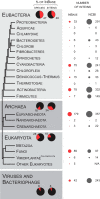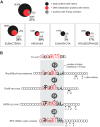Enigmatic distribution, evolution, and function of inteins
- PMID: 24695741
- PMCID: PMC4031506
- DOI: 10.1074/jbc.R114.548255
Enigmatic distribution, evolution, and function of inteins
Abstract
Inteins are mobile genetic elements capable of self-splicing post-translationally. They exist in all three domains of life including in viruses and bacteriophage, where they have a sporadic distribution even among very closely related species. In this review, we address this anomalous distribution from the point of view of the evolution of the host species as well as the intrinsic features of the inteins that contribute to their genetic mobility. We also discuss the incidence of inteins in functionally important sites of their host proteins. Finally, we describe instances of conditional protein splicing. These latter observations lead us to the hypothesis that some inteins have adapted to become sensors that play regulatory roles within their host protein, to the advantage of the organism in which they reside.
Keywords: Bioinformatics; Conditional Splicing; DNA Enzymes; Intein Gain and Loss; Intein Localization; Invasion; Microbiology; Molecular Evolution; Protein Splicing; Splicing.
© 2014 by The American Society for Biochemistry and Molecular Biology, Inc.
Figures



References
-
- Paulus H. (2001) Inteins as enzymes. Bioorg. Chem. 29, 119–129 - PubMed
-
- Muralidharan V., Muir T. W. (2006) Protein ligation: an enabling technology for the biophysical analysis of proteins. Nat. Methods 3, 429–438 - PubMed
-
- Xu M. Q., Evans T. C., Jr. (2005) Recent advances in protein splicing: manipulating proteins in vitro and in vivo. Curr. Opin. Biotechnol. 16, 440–446 - PubMed
Publication types
MeSH terms
Substances
Grants and funding
LinkOut - more resources
Full Text Sources
Other Literature Sources

